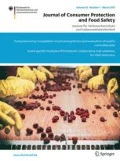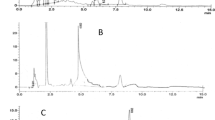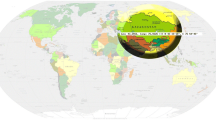Abstract
Quinalphos, an organothiophosphate chemical, is chiefly used as an insecticide. A field experiment was conducted at Bangladesh Agricultural Research Institute (BARI), to study the dissipation of quinalphos in tomato, cauliflower and bean samples when sprayed at its recommended dose and were collected from 0 (2 h after application) to 15 successive days. To determine the residual value of quinalphos, the samples were extracted in quick, easy, cheap, effective, rugged, and safe (QuEChERS) method and run through a gas chromatography-electron capture detector (GC-ECD). Higher, middle and lower concentration calibration curves were obtained with linear correlation coefficient (r2) of 0.998, 0.995 and 0.993, respectively. Limit of detection (LOD) and limit of quantification (LOQ) were found to be 0.009 and 0.027 μg mL−1, respectively. The percentages of the recovery of quinalphos residues in spiked vegetable samples at three different levels (0.625, 2.5 and 5.0 μg mL−1) were in the range of 74–86%. The amount of quinalphos residue in tomato, bean and cauliflower were in the range of 0.05–6.3, 0.05–3.1 and 0.06–6.5 μg g−1 and dissipated below maximum residue limit (MRL; 0.20, 0.20 and 0.50 μg g−1 in cauliflower, tomato and bean) value within 6, 4 and 7 days after application, respectively.

Similar content being viewed by others
References
Anastassiades M, Lehotay SJ, Stajnbaher D, Schenck FJ (2003) Fast and easy multiresidue method employing acetonitrile extraction/partitioning and dispersive solid-phase extraction for the determination of pesticide residues in produce. J AOAC Int 86:412–431
Anonymous (2009) In: package of practices for vegetables crops. Punjab Agricultural University, Ludhiana
Anonymous (2011) http://sitem.herts.ac.uk/aeru/footprint/en/Reports/576.htm
Banerjee K, Upadhyay AK, Adsule P, Pandurang G, Patil SH, Oulkar DP (2006) Food Add Contam 23:994
Chawla RP, Dhaliwal GS (1979) Dissipation of quinalphos residues on cauliflower (Brassica oleracea L. var.capitata). Phytoparasitica 7:23–29
Codex Alimentarius Commission (2010) Pesticide residues in food. FAO/WHO, Rome
EPA (2011) Environmental Protection Agency. Washington, DC
Gupta YC, Kauntey RPS (2007) Efficacy of some insecticides against brinjal shoot and fruit borer, Leucinodes orbonalis Guenee. Proc Zool Soc India 6(2):31–38
Gurminder S, Singh G, Bhardwaj U, Takkar R, Battu RS, Singh B (2011) Degradation dynamics of quinalphos on cabbage under subtropical conditions of Ludhiana, Punjab, India. Orbital Electr J Chem 3(2):104
Karanth NGK (2000) Abstract in proceedings of the international workshop, CIRAD-FAO
Nahar N, Shoeb M, Mamun MIR, Ahmed S, Hasan MM, Kabir A (2012) Studies of dissipation pattern of cypermethrin in tomato. J Bangladesh Chem Soc 25(2):200–203
Nahar N, Hossain MM, Uddin-Al-Mahmud MN, Shoeb M, Latifa GA, Kabir KH (2016) Dissipation of cypermethrin in bean and cauliflower. Dhaka Univ J Sci 64(1):89–90
Pathan A, Parihar N, Sharma B (2012) Dissipation study of quinalphos (25 EC) in/on brinjal and soil. Environ Contam Toxicol 88(6):894
Ramzan M, Singh D (1980) Chemical control of the tobacco caterpillar, Spodoptera litura Fabr. on cauliflower. J Res Punjab Agric Univ India 17(2):236–239
Sanghi R, Tewari V (2001) Monitoring of pesticide residues in fruits and vegetables from Kanpur, India. Bull Environ Contam Toxicol 67(4):587–593
Suvardhan K, Kumar SK, Chiranjeevi P (2005) Extractive spectrofluorometric determination of quinalphos using fluorescein in environmental samples. Environ Monit Asses 108:217–227
Zhang X, Shen Y, Yu XY, Liu XJ (2012) Dissipation of chlorpyrifos and residue analysis in rice, soil and water under paddy field conditions. Ecotox Environ Safe 78:276–280
Acknowledgements
ZSM thanks Dr. Md. Sultan Ahmed, Entomoly Division, Bangladesh Agricultural Research Institute (BARI), Gazipur, Bangladesh for experimental fields and Bangabandhu Fellowship on Science and ICT Project, Bangladesh for fellowship. Authors are grateful to International Science Program (ISP), Uppsala, Sweden and Higher Education Quality Enhancement Project (HEQEP) for financial supports.
Author information
Authors and Affiliations
Corresponding author
Ethics declarations
Conflict of interest
There is no conflict of interest associated with this work.
Electronic supplementary material
Below is the link to the electronic supplementary material.
Rights and permissions
About this article
Cite this article
Munia, Z.S., Shoeb, M., Mamun, M.I.R. et al. Dissipation pattern of quinalphos in cauliflower, tomato and bean samples. J Consum Prot Food Saf 13, 63–67 (2018). https://doi.org/10.1007/s00003-017-1143-8
Received:
Accepted:
Published:
Issue Date:
DOI: https://doi.org/10.1007/s00003-017-1143-8




